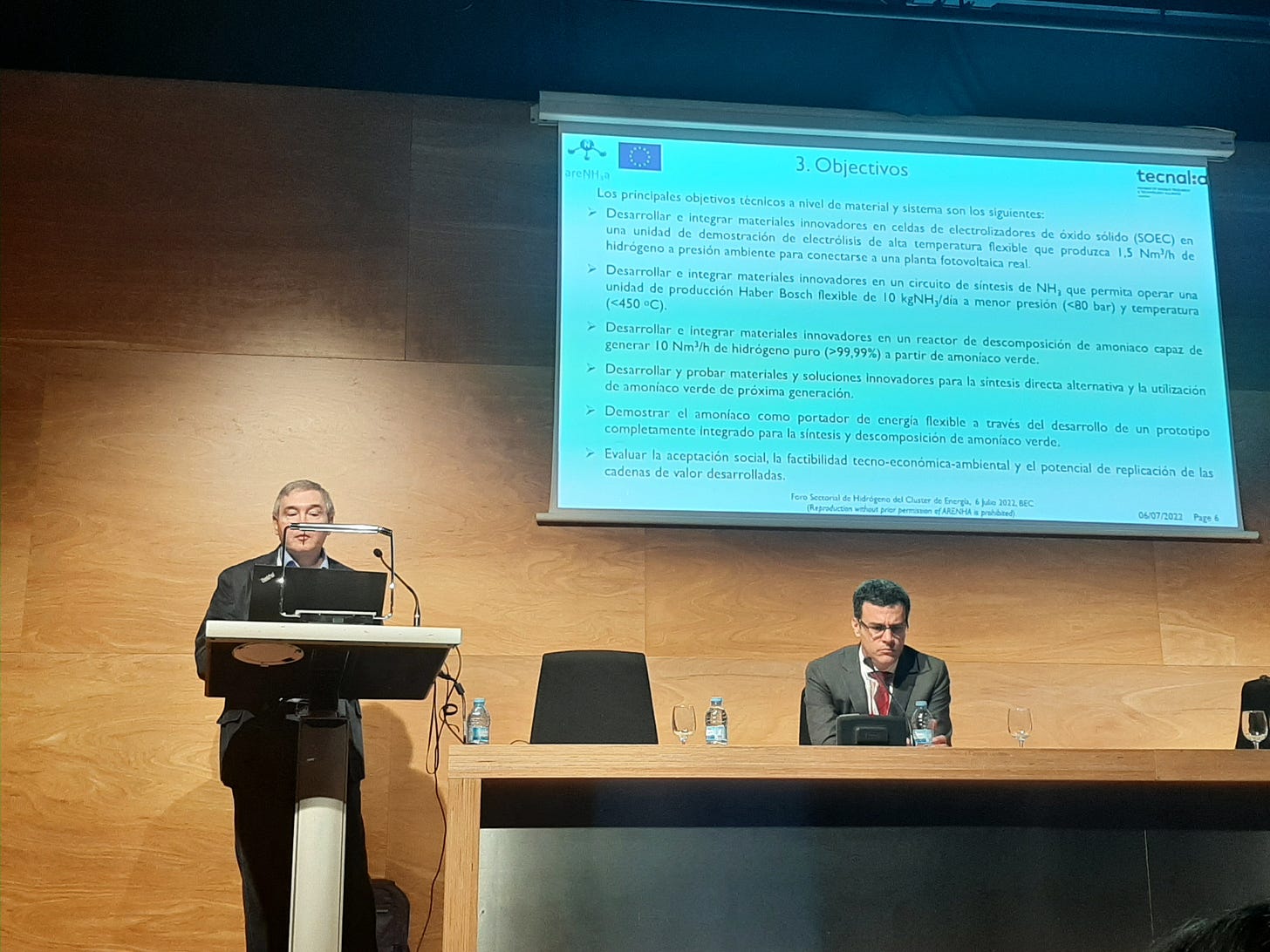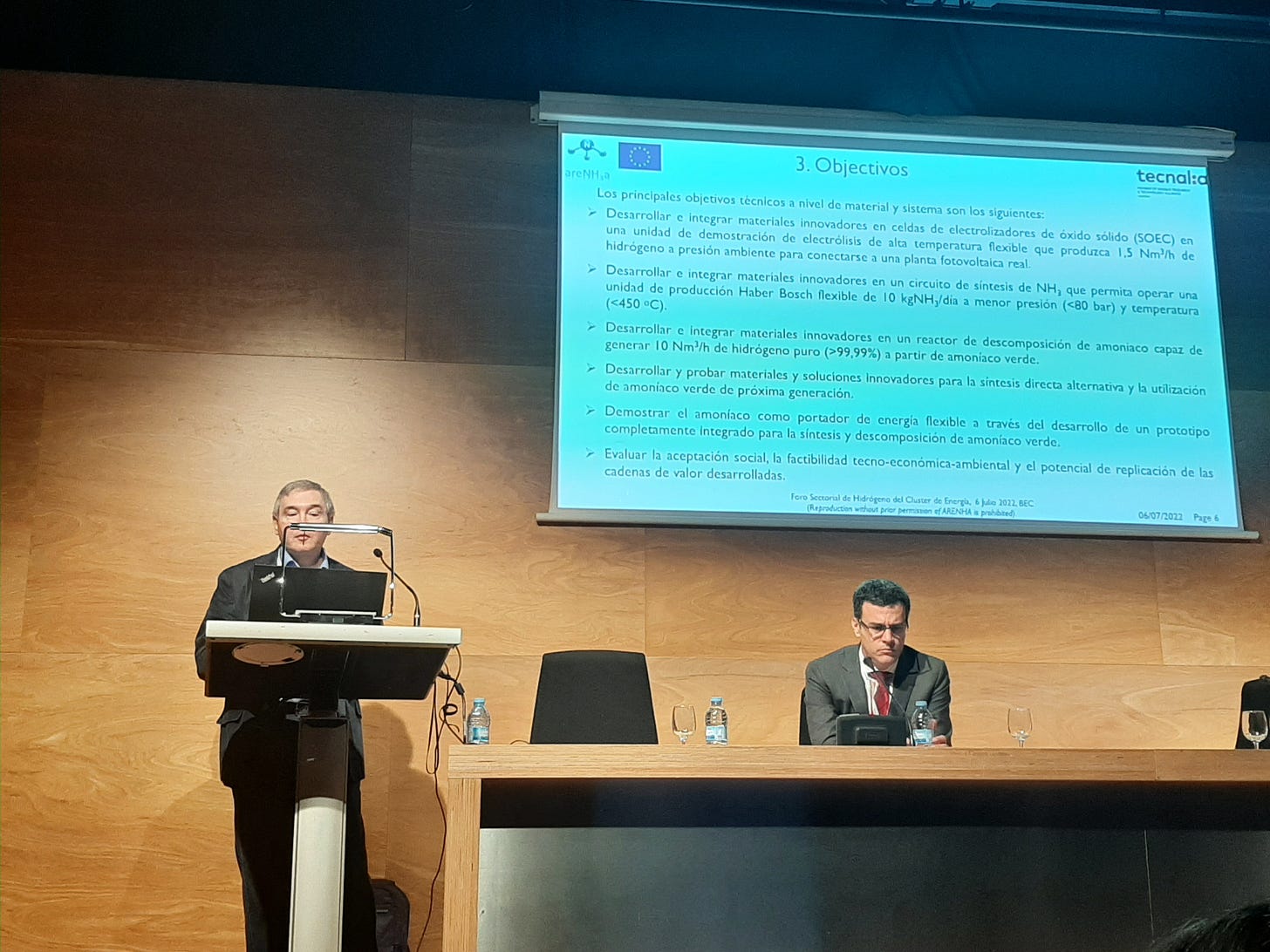30) Foro Sectorial del hidrógeno (FSH2) 6 de Julio 2022.
El 6 Julio fue el 𝐅𝐨𝐫𝐨 𝐒𝐞𝐜𝐭𝐨𝐫𝐢𝐚𝐥 𝐝𝐞𝐥 𝐇𝐢𝐝𝐫ó𝐠𝐞𝐧𝐨 del País Vasco, organizado por el Cluster de Energía | Basque Energy Cluster y coordinado por Petronor.
-Miguel Palacio (Petronor, S.A,) ha detallado los últimos avances del Corredor Vasco del Hidrógeno, destacando que hay varias empresas tramitando su incorporación.
Análogamente se ha creado el Corredor del Hidrógeno del Ebro, desde donde se va potenciar la coordinación interterritorial entre las iniciativas regionales que ya se encuentran en marcha en el noreste de España (País Vasco (BH2C Asociación ), Navarra (Agenda Navarra del Hidrógeno Verde), Aragón (Iniciativa GetHyGA) y Catalunya ( H2ValleyCat)).
-Harkaitz Ibaiondo PhD. (Ingeteam) mediante unos cálculos sencillos ha puesto de manifiesto el reto que va suponer descarbonizar el hidrógeno. Se consumen 80 MTn H₂ gris/año, y producir 1kg H₂ conlleva 50 kWh, serían necesarios 4000TWh para pasarlo a verde. Si estimamos un uso de renovables de 2000 h/año, serían 2000GW de potencia renovable. Para España, se consumen 0.6 M Tn H₂ al año \ 30TWh \ 15 GW.
-Viviente José Luis de TECNALIA Research & Innovation ha presentado el proyecto europeo ARENHA, donde durante 2020-2024 se pretende demostrar la viabilidad del amoníaco como una forma gestionable de almacenamiento de energía a gran escala. Se madurará la tecnología de toda la cadena de valor hasta TRL 5.
La ventaja del amoniaco está en disponer una alta densidad energética volumétrica (sin tener carbono). Es por ello, que puede ser un vector energético interesante (Power to X). Ya que, su uso esta estandarizado a nivel mundial al ser indispensable para la fabricación de fertilizantes.
-Jose María Canales, coordinador del Máster de Tecnologías de Hidrógeno (MITH) de Mondragon Unibertsitatea, ha avanzado que la 2º edición va camino de llenarse como la primera. También ha apuntado los “ hard skills” que demandan las empresas para el futuro descarbonizado.
-Antonio Segarra de Siemens Gamesa ha recalcado que el mercado del Oil&Gas equivale a 9337 TWh, más del doble del sistema eléctrico 3596 TWh, dejando claro que se necesita un nuevo vector energético para absorber eso. Por su parte, ha dado unas breves pinceladas sobre algunos proyectos hibridando eólico con producción de hidrogeno, como el de Haru Oni en el sur de Chile donde se pretende producir e-Metanol.
-Iñigo Santamaría de Team Engineering Consulting Group, Tekniker mediante Eva Gutierrez Berasategui y TORRAVAL Cooling, S.L. con Pablo Garrido Otaola han realizado unas presentaciones pitch para compartir su experiencia y capacidades en el ámbito del H₂.
-JOSEBA URBIETA PERO-SANZ y Raquel Ubarrechena han explicado cómo será el nuevo Parque Tecnológico de Ezkerraldea, así como la distribución del edificio EIC y Living Lab de Hidrógeno.
-José Ignacio Hormaeche Azumendi ha analizado el estudio que se ha realizado desde clúster sobre el panorama del sector energético vasco empleando datos 2017-2020.
30) Hydrogen Sector Forum (FSH2) July 6, 2022.
The 6th of July was the Basque Country's Basque Country Festival, organized by the Energy Cluster | Basque Energy Cluster and coordinated by Petronor.
-Miguel Palacio (Petronor, S.A,) has detailed the latest developments in the Basque Hydrogen Corridor, highlighting that there are several companies processing their incorporation.
Similarly, the Ebro Hydrogen Corridor has been created, from where inter-territorial coordination will be strengthened between the regional initiatives that are already underway in the northeast of Spain (Basque Country (BH2C Association), Navarra (Navarra Green Hydrogen Agenda) , Aragon (GetHyGA Initiative) and Catalonia (H2ValleyCat)).
-Harkaitz Ibaiondo PhD. (Ingeteam) through some simple calculations has revealed the challenge that decarbonizing hydrogen will entail. 80 MTn gray H₂/year are consumed, and producing 1kg H₂ requires 50 kWh, it would take 4000TWh to turn it green. If we estimate a use of renewables of 2,000 h/year, that would be 2,000 GW of renewable power. For Spain, 0.6 M Tn H₂ are consumed per year \ 30TWh \ 15 GW.
-Viviente José Luis from TECNALIA Research & Innovation has presented the ARENHA European project, where during 2020-2024 the aim is to demonstrate the viability of ammonia as a manageable form of large-scale energy storage. The technology of the entire value chain will be matured up to TRL 5.
The advantage of ammonia is in having a high volumetric energy density (without having carbon). That is why it can be an interesting energy vector (Power to X). Since, its use is standardized worldwide as it is essential for the manufacture of fertilizers.
-Jose María Canales, coordinator of the Master's Degree in Hydrogen Technologies (MITH) at Mondragon Unibertsitatea, has advanced that the 2nd edition is on the way to filling up like the first. He has also pointed out the "hard skills" that companies demand for the decarbonized future.
-Antonio Segarra from Siemens Gamesa has stressed that the Oil & Gas market is equivalent to 9,337 TWh, more than double the 3,596 TWh electrical system, making it clear that a new energy vector is needed to absorb that. For his part, he has given a few brief touches on some projects hybridizing wind power with hydrogen production, such as Haru Oni in southern Chile where e-Methanol is intended to be produced.
-Iñigo Santamaría from Team Engineering Consulting Group, Tekniker through Eva Gutierrez Berasategui and TORRAVAL Cooling, S.L. with Pablo Garrido Otaola they have made some pitch presentations to share their experience and skills in the field of H₂.
-JOSEBA URBIETA PERO-SANZ and Raquel Ubarrechena have explained what the new Ezkerraldea Technology Park will be like, as well as the distribution of the EIC building and Hydrogen Living Lab.
-José Ignacio Hormaeche Azumendi has analyzed the study that has been carried out by the cluster on the panorama of the Basque energy sector using data from 2017-2020.






